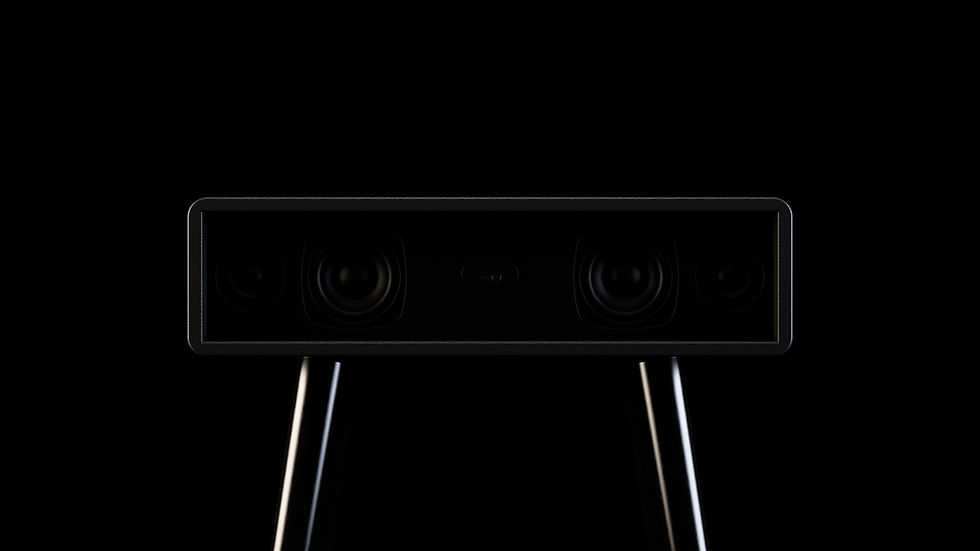Innovative Product Development Solutions: Trends and Techniques Shaping the Future
- Alexander Ulkin
- Dec 28, 2024
- 9 min read
Updated: May 25
In today's digital age, innovation drives success. As industries evolve, businesses must stay competitive by adopting groundbreaking product development solutions to adapt to customer demands and stay ahead in an ever-changing market. The rise of 3D rendering and animation has transformed how companies approach product design, enabling them to create immersive experiences, visualize concepts, and bring ideas to life before production. This article dives deep into the evolving landscape of product development, focusing on trends, techniques, and the pivotal role of 3D rendering in revolutionizing how products are designed, developed, and marketed.

The Importance of Modern Product Development Solutions
Product development solutions encompass a range of tools, methods, and processes that streamline the journey from concept to completion. Development techniques are transforming how companies design products in industries like automotive, consumer electronics, healthcare, and fashion. To stand out in a saturated market, brands now turn to sophisticated 3D rendering, product animation, and video post-production to effectively engage audiences, convey product value, and test designs.
By integrating technologies like product rendering and 3D animation, companies can dramatically cut costs, reduce production times, and ensure products resonate with target audiences. Moreover, as sustainability becomes a priority, these digital tools allow for more eco-friendly workflows by minimizing the need for physical prototypes.

How 3D Rendering is Changing Product Development
3D rendering revolutionizes industries, providing a realistic and cost-effective product presentation method. By enabling designers to produce high-quality visuals, 3D product rendering services help stakeholders visualize the end product, make informed decisions, and detect potential design flaws early.
Advanced 3D rendering software like Autodesk 3ds Max, Blender, and Cinema 4D allows for precise, photorealistic renderings that simulate lighting, textures, and shadows, offering a true-to-life view of the product. This not only benefits design teams but also empowers marketing teams to create compelling, immersive visuals for advertising, including 3D videos and animated marketing videos.
Key Benefits of 3D Rendering in Product Development
Cost Efficiency
3D rendering dramatically lowers the necessity for physical prototypes, yielding substantial time and material cost savings. By eliminating the need for numerous iterations of physical samples, companies can allocate resources more strategically and focus on refining their products.
Design Flexibility
The ability to modify designs in real-time fosters seamless collaboration among team members and stakeholders across multiple disciplines. This heightened flexibility minimizes the risk of costly errors emerging during later stages of development, ultimately enhancing projects' overall agility.
Enhanced Visualization
High-quality visualizations transform stakeholders' ability to engage with the product concept. Offering a comprehensive, immersive viewing experience, these renderings help decision-makers feel assured in their choices early in the product development lifecycle when feedback can most effectively shape outcomes.
Effective Marketing
Leveraging high-quality product renderings lays a robust foundation for marketing initiatives. These engaging visuals build consumer anticipation and trust before products reach the market, enabling brands to create buzz and eagerness.

Emerging Trends in Product Development Solutions
The rapid advancement of technology continues to shape product development. Innovations in artificial intelligence, machine learning, and data analytics are transforming traditional workflows, while 3D modeling and animation drive creativity and functionality. Let's explore some key trends that are reshaping the industry.
Artificial Intelligence in Product Development
AI is at the forefront of digital transformation, profoundly impacting product design and development services. Using AI algorithms, designers can analyze vast datasets to anticipate market trends, predict consumer preferences, and fine-tune designs based on customer feedback. AI also enables predictive analytics, which supports decision-making at every stage of development.
Virtual Reality and Augmented Reality
Virtual Reality (VR) and Augmented Reality (AR) are expanding possibilities within product development. By creating immersive experiences, VR and AR allow for interactive prototypes that enhance testing and validation. This immersive technology is particularly beneficial for product 3D rendering, enabling stakeholders to explore products in a simulated environment before they go into production.
Sustainability and Eco-Friendly Product Design
Today's consumers value sustainability, pushing brands to adopt eco-friendly practices in their development processes. Virtual prototypes and 3D product rendering reduce the need for physical samples, leading to less material waste. Sustainable designs often rely on digital solutions to assess environmental impact before production, ensuring that products meet green standards.

Real-Time Collaboration with Cloud-Based Tools
Cloud-based collaboration tools have become essential in modern product development. These platforms enable teams to access designs, share feedback, and update files in real time, making product development consulting more efficient. Tools like Autodesk Fusion 360 facilitate seamless teamwork, where designers and engineers from different locations can collaborate on complex projects.
Techniques Shaping the Future of Product Development
As product development becomes more intricate, advanced techniques are paramount. Techniques such as rapid prototyping, animation production, and social media video editing allow companies to convey their visions more effectively. Below are some of the most impactful techniques transforming the industry.

Rapid Prototyping
Rapid prototyping is a technique for quickly and cost-effectively creating functional product models. When combined with 3D rendering and product animation, it enables developers to showcase realistic product models and gather feedback early on. This approach is essential in industries like automotive and aerospace, where functionality and safety are critical.
Digital Twin Technology
Digital twins are virtual representations of physical products, allowing developers to test their performance in real-world scenarios without building a physical prototype. This technique, often supported by 3D animation companies, is gaining traction in sectors where reliability is paramount, such as manufacturing and healthcare.
Motion Graphics and Animated Product Videos
With digital marketing increasing, brands are turning to animated marketing videos and 3D animation movies to showcase products dynamically. Platforms like Adobe After Effects enable 3D animators to add motion graphics, bringing otherwise static product features to life. For instance, an animated video of a new smartphone can highlight its features and performance, providing viewers with a memorable experience that helps build product anticipation.
Leveraging 3D Animation in Product Development
3D animation is a powerful tool in modern product development, allowing brands to communicate complex ideas quickly. By creating animated visuals, designers can showcase the intricate details of their products, explain functionalities, and simulate user experiences, all of which play crucial roles in marketing and product education.
3D animation also opens up endless creative opportunities, enabling companies to create complete virtual experiences for their products. For example, animated product demos can enhance user manuals, making them more engaging and accessible. Additionally, 3D animation companies can help brands develop immersive 3D product animation services that captivate audiences and highlight product value like never before.
How 3D Animations Improve Product Presentations
Interactive Storytelling
Engages the audience by demonstrating the product's features, benefits, and use cases in a captivating manner.
Enhanced User Understanding
Provides a clear understanding of the product's functionality, especially for complex machinery or electronics.
Higher Customer Retention
Studies show that animated content increases engagement, making consumers more likely to remember and purchase the product.
3D Product Rendering: Bringing Concepts to Life
3D product rendering services give brands a digital way to visualize their ideas and bring them to life. Using applications such as ZBrush, KeyShot, and V-Ray, designers can create hyper-realistic renderings that make products look like they're already in the consumer's hands. This process also enables companies to adjust before production, ensuring the final product meets quality standards.
With the demand for visual content on social media and e-commerce platforms, 3D product rendering companies are invaluable for businesses aiming to maintain a visually appealing online presence. They allow for high-quality, flexible product imagery that resonates across platforms.
Advantages of Product Renders in Marketing
Increased Visual Appeal
Product renders are polished and visually compelling, making them ideal for advertising and promotional materials.
Brand Consistency
3D renders maintain consistent lighting, angles, and aesthetics across all product images, establishing a cohesive brand look.
Scalable Content
Once a 3D model is rendered, it can be reused across various platforms, from social media to product pages, without additional photography costs.
Why Video Post-production is Crucial in Product Development
Video post-production has become increasingly relevant in modern product marketing, enabling brands to deliver more immersive content. Through social media video editing and special effects, companies can elevate the final product video and make it captivating for the viewer. Post-production also allows for adding subtitles, graphics, and animations, enhancing the visual narrative and supporting better consumer understanding.
Post-Production Techniques in 3D Product Animation
Color Grading
Ensures that colors are consistent and appealing, enhancing the overall look and feel of the video.
Sound Design
Adding background music or sound effects makes videos more engaging and helps to convey emotions.
Visual Effects (VFX)
Allows for creating dynamic effects that capture attention, such as particles, explosions, or lighting effects in animated scenes.
The Role of 3D Modeling Companies in Product Development
With expertise in 3D design, 3D modeling companies provide the technical and creative skills necessary for bringing products to life. These companies are skilled in creating intricate 3D models for prototyping, marketing, or detailed engineering purposes. Partnering with a reputable 3D modeling company is invaluable for brands seeking to innovate confidently, as it grants them access to advanced design tools, expertise, and cutting-edge technology.
For instance, 3D animators specializing in product development use tools like Maya and Houdini to create detailed models and animations, allowing companies to illustrate the value and functionality of their products in a visually appealing way.
Choosing a Product Development Partner for 3D Services
Selecting the right product development partner can be a game-changer for businesses. A reliable partner, such as a full-service production company specializing in 3D product rendering, can offer comprehensive services from design to animation, including consulting, video editing, and final product renderings. This approach allows companies to streamline workflows, reduce costs, and ensure quality at every stage.
Key Factors to Consider When Choosing a 3D Product Rendering Company
Experience and Portfolio
Review the company's portfolio to ensure its style aligns with your vision and industry standards.
Technical Expertise
Ensure the company is proficient in popular 3D software such as Blender, 3ds Max, and After Effects.
Range of Services
A company that offers product design, rendering, and animation production as part of its product development solutions package can simplify the overall process.
Embracing the Future of 3D Rendering and Animation with Coast Team Studio
The future of product development solutions hinges on the ability to seamlessly integrate advanced tools like 3D rendering and animation, ultimately leading to more innovative, efficient, and impactful products. As the demand for engaging visual content grows, companies require a reliable partner to bring their product visions to life with expert precision. Coast Team Studio offers a full suite of 3D services, including product 3D rendering and product animation for various industries, transforming ideas into powerful visual assets that leave a lasting impression.
The Impact of Social Media on Product Development and Marketing
In today's interconnected world, social media isn't just a platform for interaction; it's a driving force in product development solutions and marketing strategies. Brands leverage social media to gather consumer insights, test new ideas, and understand market needs in real-time. Through social media video editing and 3D animation movies, companies can showcase products creatively, driving engagement and fostering a loyal community around their brand.
By sharing product animations or 3D videos on platforms like Instagram and YouTube, companies can gauge public response early on, allowing them to make adjustments even before launching the product. This approach creates a sense of inclusion among potential customers, who appreciate the behind-the-scenes look and feel more connected to the product's journey.
Key Social Media Strategies in Product Development
Influencer Collaboration
Partnering with influencers allows brands to introduce products through trusted voices, increasing credibility and reach.
User-Generated Content
Encouraging customers to share their experiences with the product on social media creates an authentic image and helps gather valuable feedback.
Interactive Campaigns
Polls, quizzes, and live demos can offer insights into customer preferences, assisting brands to fine-tune their product features and messaging.
The Role of 3D Animators in Realizing Product Development Goals
The demand for skilled 3D animators is rising as more brands incorporate 3D elements into their product development and marketing strategies. These animators bring concepts to life, visualizing everything from sleek smartphone designs to complex industrial machinery. A 3D modeling company often employs a team of skilled animators and designers who can translate a brand's vision into detailed, animated visuals that captivate and educate.
Through powerful software like Autodesk Maya, Houdini, and Blender, animators can create product visualizations that highlight every detail, feature, and function. This detailed approach benefits industries like healthcare and technology, where understanding functionality is crucial. Companies rely on 3D product animation services to simplify complex product descriptions and make them accessible to broader audiences.
Advantages of Partnering with Expert 3D Animators
Enhanced Storytelling
Expert animators can transform a simple product feature into a compelling story, capturing the audience's attention.
Technical Precision
Professional animators are skilled in creating precise and accurate models, which is essential for products that require careful technical representation.
Innovative Marketing
Animated videos stand out on social media and e-commerce platforms, giving brands an edge in a competitive digital landscape.
The Future of 3D Product Rendering in Virtual and Augmented Reality
With Virtual Reality (VR) and Augmented Reality (AR) technologies continuing to grow, the role of 3D product rendering is expanding in exciting new ways. These immersive technologies allow users to engage with products in virtual environments, a trend that has seen rapid adoption in fields like real estate, automotive, and fashion.
By providing consumers with an interactive experience, VR and AR facilitate a deeper understanding of the product, allowing users to explore details and features in real time. This immersive experience is beneficial for customer satisfaction and product development consulting, as it enables brands to gather precise feedback on design and usability.
Benefits of VR and AR in Product Development Solutions
Enhanced Customer Engagement
VR and AR allow customers to interact with products, increasing emotional connection and loyalty.
Reduced Returns
Customers who experience a product virtually before purchasing are more confident in their decisions, reducing return rates.
Efficient Testing
Companies can test various product features within a virtual environment, making adjustments before physical prototypes are produced, saving on material costs.
Conclusion: 3D Product Rendering Companies as Strategic Partners
As industries evolve, the demand for immersive, visually stunning, and interactive product development techniques grows stronger. Companies need partners with the expertise, creativity, and technical capabilities to bring their ideas to life. A reliable 3D product rendering company such as Coast Team Studio offers a full range of services, from product renderings and animations to consulting and post-production. Working with a team like this can turn ambitious product concepts into captivating visual assets that engage, educate, and inspire, setting brands apart in a competitive marketplace.




Comments